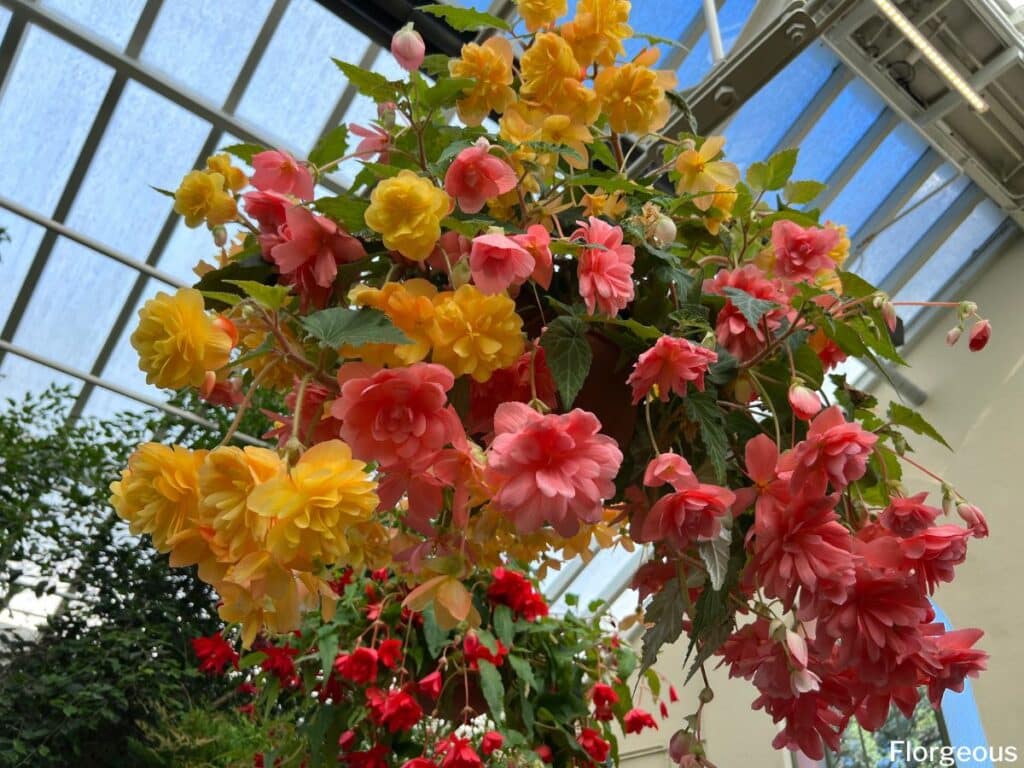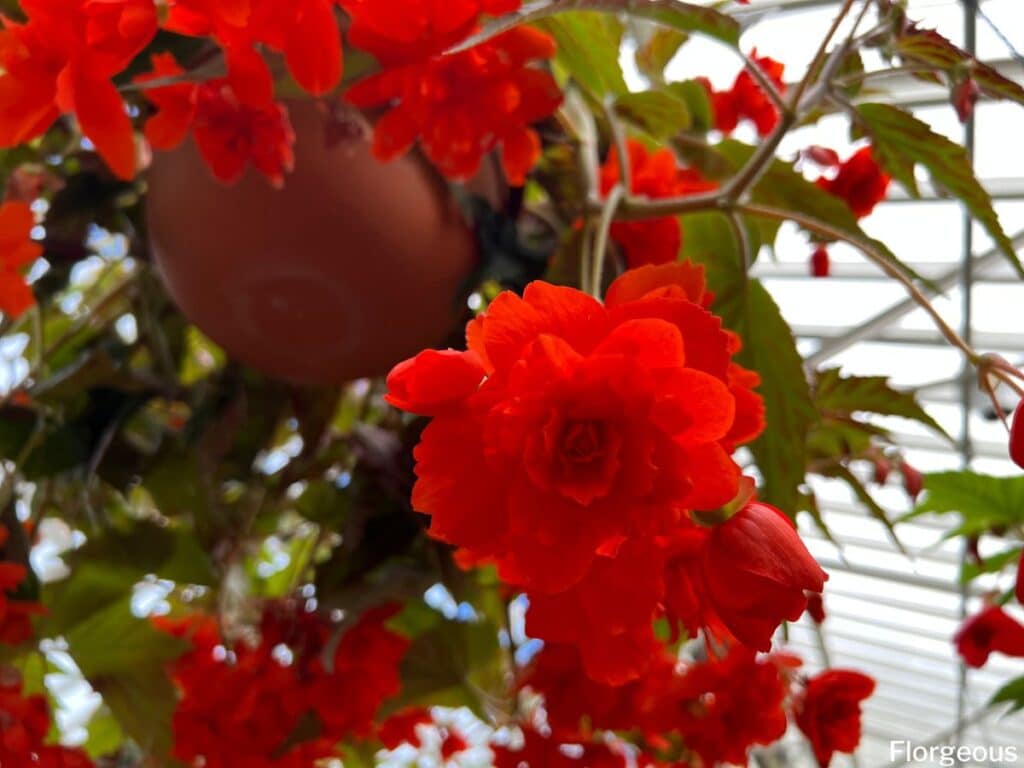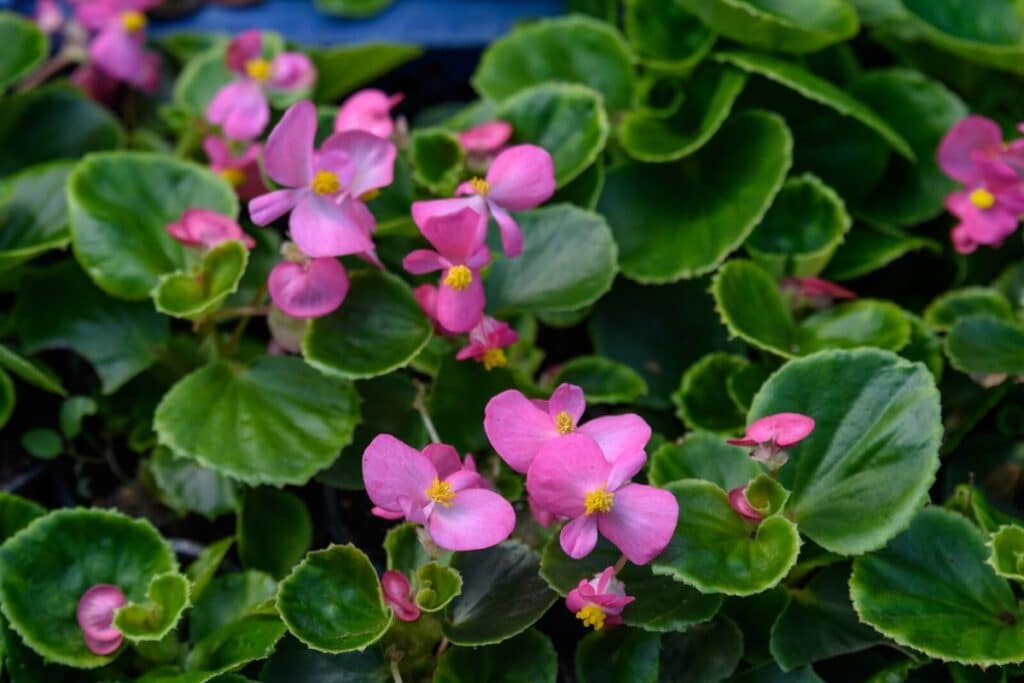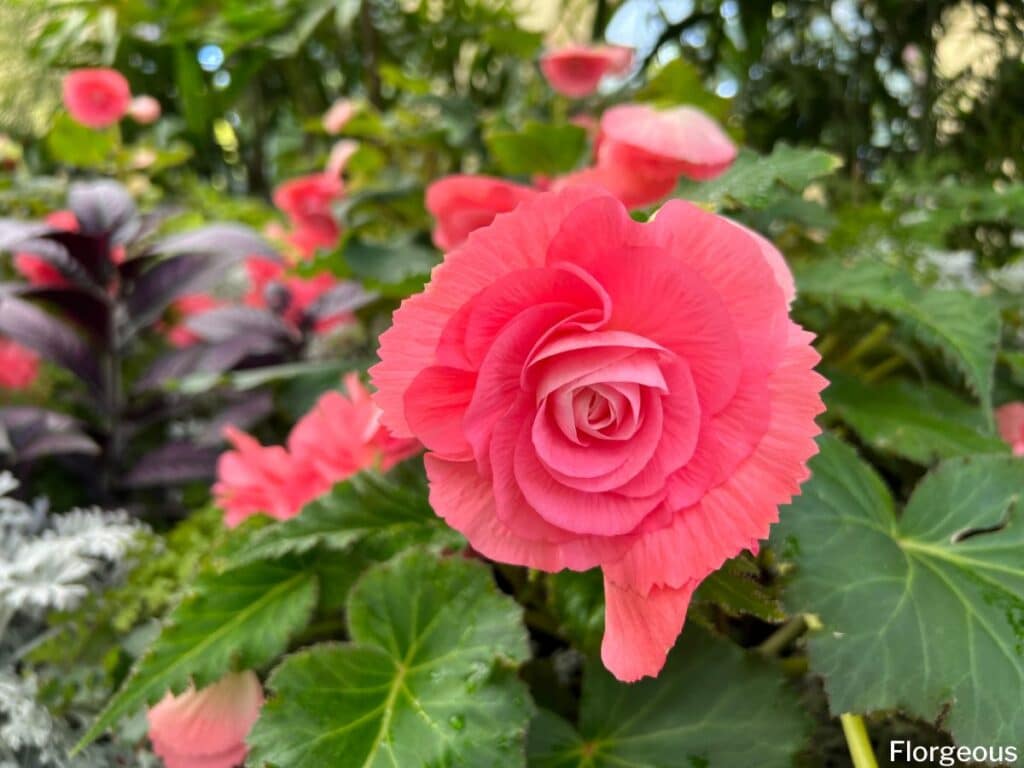Begonia is a genus and common name of flowering plants from the family Begoniaceae. Begonias are believed to have originated in Brazil, but some are also found earlier in Mexico and even China.
The name “Begonia” was given by a Franciscan Monk who named it after Michel Begon, a former governor of Haiti.
What is a Begonia Plant?
Begonia is one of the largest genera of flowering plants with over 1900 species. They are pantropic plants which mean they are found naturally in tropical and subtropical regions around the world, except in Australia.
Begonias are terrestrial plants. In the wild, they can either grow in stems, rhizomes, or in tubers. Begonia plants have distinct dark green foliage. Their leaves are large and asymmetric with various patterns and prominent venation.
Another distinct feature of begonias is their flowers. Begonias are monoecious, which means the flowers are unisexual with both male and female flowers blooming separately on the same plant.
The flowers have sepals that vary in color depending on the variety. Begonias flower year-round, except some tuberous species.

Where Do Begonias Grow?
Begonias are a type of flowering plant that is native to tropical and subtropical regions.
They can be found growing in the wild in Africa, Asia, and South America. In these areas, begonias typically grow in shady, moist locations such as forests and wet meadows. However, they can also be grown as houseplants in more temperate climates.
Begonias require warm temperatures and high humidity levels to thrive. As a result, they are typically only planted outdoors in usda hardiness zones 10 and 11.
However, there are some varieties of begonia that can tolerate cooler temperatures. These varieties are often grown as annuals in areas with colder winters.

What Are the Different Kinds of Begonia Flowers?
There are over 1,300 species of begonia, and they come in a wide variety of shapes, sizes, and colors. Some begonias have round leaves, while others have ruffled or feathery leaves. Some begonia varieties produce large flowers, while others have small, delicate blooms.
Begonias are native to tropical and subtropical regions around the world, and they have been widely cultivated as ornamental plants for centuries. However, they are relatively easy to care for and can be grown in a wide range of climates.
As a result, begonias have become one of the most popular houseplants in the world.
There are hundreds of different kinds of begonia. If you’re looking for a versatile and colorful plant to add to your home, begonias are a great option. These popular plants come in a wide range of varieties, each with its own distinct appearance. Here are some of the most popular begonia varieties:
- Wax begonias are one of the most common types of begonia. Also known as bedding begonias and annual begonias, they are characterized by their glossy, waxy leaves, which can be green, red, or bronze in color. Wax begonia plants are easy to care for and make an excellent addition to any indoor or outdoor space.
- Tuberous begonias are another popular type of begonia. This variety is characterized by its large tuberous roots, which store water and nutrients. Tuberous begonias are known for their beautiful, small white, pink, or red flowers. These plants prefer cooler temperatures and should be protected from frost.
- Rex begonias are a type of begonia that is prized for its lush, colorful foliage. The leaves of rex begonias can be green, red, purple, or brown in color and are often variegated or patterned. These plants prefer warm temperatures and high humidity levels.
With so many different kinds to choose from, there is sure to be a begonia that is perfect for any home.

How to Plant Begonias
When planting begonias, it is important to choose a location that receives partial sun and has well-drained soil. Full sun can be tolerated by some begonia cane types, but not all, so make sure you check into this.
Begonias should be planted in early spring, after the last frost. The best way to plant begonias is to dig a hole that is twice as wide as the plant’s root ball. After placing the plant in the hole, fill it with soil and water deeply.
Begonias require regular watering, especially during periods of hot, dry weather. More on begonia care tips are below!
With just a little care, begonias can add color and beauty to any garden.
How To Care For Begonias
Begonias are a popular choice for indoor plants because they are relatively easy to care for and come in a wide range of colors and sizes. While there are many different varieties of begonia, most can be cared for in a similar way. Here are a few tips to help you keep your begonia healthy and vibrant.
Sunlight
Despite being tropical and subtropical plants, begonias are shade-loving plants. Their leaves can be damaged when exposed to direct sunlight.
Some species, such as wax begonias, can tolerate direct sunlight, but some, like tuberous begonias, prefer more shade. Angel wing begonias (also known as cane begonias) thrive in dappled shaded areas but can also tolerate heavy shade.
In general, begonia plants can be placed in sunny areas with indirect light. Keep this growing condition in mind when choosing begonia companion plants.
Temp and Humidity
Begonias are especially sensitive to cold temperatures. They should be kept in temperatures ranging from 75-85F (23-29C). There are hardy begonias, but even many of these can’t handle a heavy first frost and should be moved inside once the danger of frost appears. If you don’t want to bring your begonias inside, planting them in a greenhouse for the winter is always an option!
Begonias also love high humidity. Many begonia rex varieties, in particular, are fuzzy when it comes to its humidity requirements so make sure to keep air humidity high while making sure not to encourage the growth of powdery mildew.
How Much Water Does Begonia Need?
These plants grow best in moist soil, but they are susceptible to root rot with too frequent watering. To avoid this, watering should be done regularly once the top inch soil is nearly dry.
Begonias prefer evenly moist soil, so it’s important to water them regularly. When watering begonias, use tepid water rather than cold water. Cold water can shock the plants and damage their leaves.
Soil and Fertilizer
Since begonia plants are susceptible to root rot, it is important to use well-draining potting/growing media.
A mixture of peat with a small amount of gardening soil and perlite would be perfect for begonias. They do not require a lot of fertilizer. A half-strength mixture of general fertilizer applied every two weeks would be enough.
If you want perfect blooms during the flowering season, you can exchange the general fertilizer with a high phosphorus one.
Propagation Methods
There are different methods of propagating begonias based on their group category. Wax begonias are propagated with stem cuttings and leaf cuttings.
Tuberous and rhizomatous begonias can be propagated through their tubers and rhizomes. Begonias can also be propagated directly through seeds.
Propagation by cuttings is done by obtaining a leaf, removing some veins on the underside, and placing them on a moist medium such as sand.
Common Begonia Pests and Diseases
Begonia plants are relatively easy to care for, but they can be susceptible to a range of pests and diseases.
Some of the most common begonia pests include aphids, mealybugs, and whiteflies. These small insects can feed on the plant’s sap, causing stunted growth and yellowing leaves. Slugs and snails can also be problematic, especially for a tender new plant during wet weather.
Overwatering can cause root rot, as well as stem rot and powdery mildew.
This includes watering them regularly, keeping them in a bright location, and ensuring that the soil drains well. If you do notice any pests or diseases on your begonias, be sure to treat them promptly in order to prevent further damage.

Can You Grow Begonias as Houseplants?
Begonias are one of the most popular houseplants because they are relatively easy to care for and come in a wide variety of colors and shapes. Though they are typically grown as annuals outdoors, begonias can also be successfully grown as houseplants.
You can grow begonias indoors healthy by providing bright filtered light and consistent moisture.
Potted begonias should be watered regularly, but allowed to dry out slightly between waterings. They also benefit from high humidity, so it is a good idea to set them on a pebble tray or mist them regularly.
Also, make sure to choose a pot that is appropriate for the size of your plant. Begonias can quickly become rootbound, so it is important to provide them with enough room to grow.
With proper care, begonias make lovely houseplants that add color and life to any room. They’re also great for places like window boxes and hanging baskets!
Are Begonias Toxic to Pets and Humans?
Begonias contain oxalate crystals in their roots and some on the stem. These crystals are irritants and can cause inflammation of the mouth and throat when ingested. Since the roots are underground, exposure to these crystals is unusual, but caution should still be observed if you have children and pets.
Begonia as a Culinary and Medicinal Plant
Aside from their use as ornamental plants, begonias also have food and medicinal value. Tuberous begonias are known to have edible leaves and pale pink flowers. The parts are used in spreads, dips, and salads. Some species of begonia are also used in folkloric medicine.
In India, one species of Begonia, B. malabrica, is used by tribal communities as a cure to arthritis and common joint pains. Another species, B. cucullate, is reported to have anti-inflammatory, antimalarial, and diuretic properties.

Where to Buy Begonias for Sale
The best place to buy begonias is at a local nursery or garden center. This way, you can see the plants in person and choose the ones that best suit your needs. You can also ask the staff for advice on care and planting.
If you’re buying begonias online, be sure to do your research and purchase from a reputable source. This will ensure that you receive healthy plants that will thrive in your garden.
FAQs
How do you care for potted begonias?
Care for potted begonias by providing well-draining potting soil, keeping consistently moist soil but not soggy soil, and placing them in a location with filtered light or indirect sunlight.
How do you keep begonias blooming?
Keep begonias blooming by deadheading spent flowers regularly to encourage the production of new blooms. Additionally, ensure they receive appropriate light, water, and periodic feeding with a balanced fertilizer.
Do begonias like morning or evening sun?
Begonias generally prefer morning sun or filtered light rather than direct evening sun, which can be harsh. Providing them with bright, indirect light or dappled sunlight ensures optimal growing begonias conditions and blooming.
Final Thoughts
Begonia are a beautiful addition to any garden, and with a little bit of care they can provide years of enjoyment. Consider these tips when growing and caring for your begonias, and you’ll be able to enjoy their beauty for seasons to come.
Up next:
References
Reference list
(1) Hvoslef-Eide A.K., Munster C. “Begonia”. In: Anderson N.O. (eds) “Flower Breeding and Genetics”. Springer, Dordrecht. 2007.
(2) Ellis B.W. et al. “The Organic Gardener’s Handbook of Natural Insect and Disease Control: A Complete Problem-Solving Guide to Keeping Your Garden and Yard Healthy Without Chemicals”. Rodale Press. Penn. 1996. PP 39-41.
(3) Lim T.K. “Edible Medicinal and Non-Medicinal Plants.” Vol 7. Springer Science and Business Media. 2013. PP 551-557.
(4) Suresh M. et al. “A Short review on Ethnomedicinal uses, phytochemistry and pharmacology of Begonia malabarica Lam.” International Journal of Botany Studies. 1(6). 2016. PP 16-17.
(5) Knight A. “A Guide to Poisonous House and Garden Plants”. CRC Press. 2007. PP 45-46.
(6) Murphy D.M. Duea A.W. “The Complete Guide to Growing Windowsill Plants: Everything You Need to Know Explained Simply”. Atlantic Publishing Company. 2011. PP 106-112.
(7) Wyman D. “Wyman’s Gardening Encyclopedia”. Simon and Schuster. 1986. P 112.
Close
*Photo by [email protected]/depositphotos







